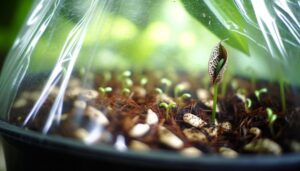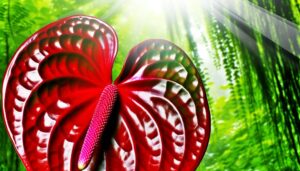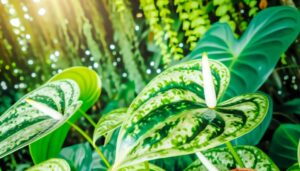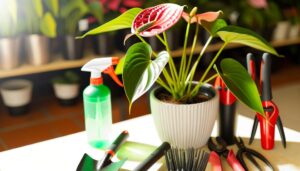Best Conditions for Growing Anthurium Warocqueanum Seedlings
To optimize Anthurium Warocqueanum seedling growth, maintain temperatures between 70-85°F (21-29°C) and provide bright, indirect light at 10,000-20,000 lux. Keep humidity levels at 70-80% and water using rainwater or distilled water once to twice a week.
Utilize a well-draining soil mix composed of orchid bark, perlite, and sphagnum moss, and apply a balanced, water-soluble fertilizer bi-weekly. Assure effective air circulation and monitor closely for pests such as spider mites and aphids.
Repot every 6-12 months using an aerated substrate to accommodate growing roots. For a deeper understanding, you can explore more detailed strategies and practices.

Key Takeaways
- Maintain temperatures between 70-85°F (21-29°C) for optimal growth.
- Provide bright, indirect sunlight with 10,000-20,000 lux.
- Keep humidity levels at 70-80% and water once to twice a week.
- Use a well-draining soil mix with orchid bark, perlite, and sphagnum moss.
- Apply a balanced, water-soluble fertilizer bi-weekly.
Ideal Temperature Range
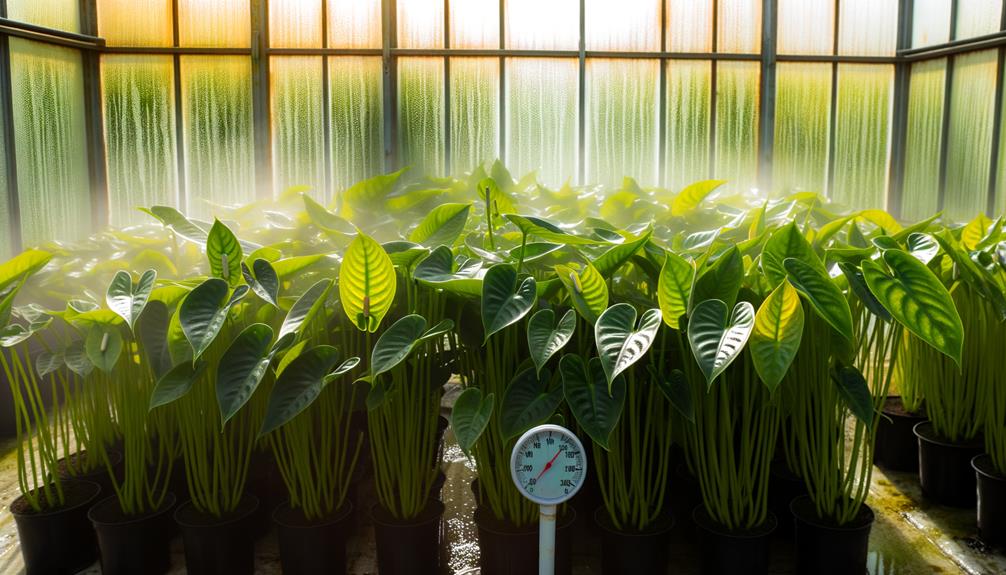
Maintaining a perfect temperature range of 70-85°F (21-29°C) is crucial for the best growth and development of Anthurium warocqueanum seedlings.
This specific temperature range enhances metabolic processes, including photosynthesis and respiration, which are crucial for seedling vigor.
Temperatures below 70°F can slow enzymatic activity, hindering growth, while temperatures above 85°F risk causing heat stress, negatively affecting cellular functions and potentially leading to tissue damage.
Additionally, this range supports the best uptake of nutrients and water from the growing medium, facilitating strong root development.
Consistent temperature control is important as fluctuations can trigger stress responses, reducing overall plant health.
Utilizing thermostatically regulated growing environments ensures precision in maintaining these conditions, thereby promoting ideal seedling development.
Humidity Requirements
Maintaining best humidity levels is essential for the successful growth of Anthurium Warocqueanum seedlings, with a preference for environments that sustain 70-80% relative humidity.
Various humidity control methods, including the use of humidifiers, humidity trays, and regular misting, can effectively achieve these conditions.
Recognizing signs of low humidity, such as browning leaf edges and stunted growth, is crucial for timely corrective action.
Optimal Humidity Levels
Achieving a relative humidity of 70-80% is crucial for the healthy growth and development of Anthurium Warocqueanum seedlings.
This specific humidity range replicates the natural tropical environment of this species, facilitating ideal physiological processes such as transpiration and nutrient uptake.
Inadequate humidity levels can lead to desiccation of the delicate foliage, hindering photosynthesis and overall growth.
Conversely, excessive humidity may promote fungal and bacterial infections. Monitoring humidity is critical, as even minor fluctuations can have a significant impact on seedling vigor.
Consistent humidity within the specified range supports robust leaf expansion and root development.
As a result, maintaining these conditions is essential for ensuring the successful cultivation of Anthurium Warocqueanum seedlings.
Humidity Control Methods
To effectively manage the humidity levels needed for Anthurium Warocqueanum seedlings, deploying a combination of humidifiers, pebble trays, and regular misting can create a stable microenvironment conducive to ideal growth.
Humidifiers are particularly effective in maintaining consistent humidity levels between 80% and 90%, crucial for these tropical plants.
Pebble trays, filled with water and placed beneath the plant pots, increase localized humidity through evaporation.
Regular misting enhances humidity but must be done with caution to avoid over-saturation, which could lead to fungal issues.
Monitoring tools such as hygrometers are indispensable for ensuring that humidity levels remain within the best range.
This multi-faceted approach guarantees a stable and controlled environment, fostering healthy Anthurium Warocqueanum seedling development.
Signs of Low Humidity
Identifying signs of low moisture in Anthurium Warocqueanum seedlings is crucial, as inadequate humidity levels can manifest through symptoms such as brown leaf tips, stunted growth, and increased vulnerability to pests and diseases.
Low humidity affects the plant’s ability to transpire efficiently, leading to physiological stress and impaired nutrient uptake.
Regular monitoring of environmental conditions and visual inspection of seedlings are essential practices.
Below is a table summarizing the signs and their implications:
| Sign | Implication |
|---|---|
| Brown Leaf Tips | Desiccation and cellular damage |
| Stunted Growth | Inhibited metabolic processes |
| Leaf Drop | Severe stress response |
| Pest Infestation | Weakened plant defenses |
Maintaining ideal moisture levels, ideally between 70-80%, promotes robust growth and resilience in Anthurium Warocqueanum seedlings.
Light Conditions

Perfect light conditions for Anthurium Warocqueanum seedlings involve providing bright, indirect sunlight to promote healthy growth and prevent leaf burn.
These seedlings thrive under filtered light, avoiding direct sun exposure, which can scorch their delicate leaves.
Best light levels range between 10,000-20,000 lux, often achievable through sheer curtains or positioning near east-facing windows.
Artificial lighting, such as fluorescent or LED grow lights, can supplement natural light, ensuring consistent exposure for 10-12 hours daily.
Monitoring light intensity with a lux meter can help maintain ideal conditions. Insufficient light may result in elongated stems and pale foliage, while excessive light can cause leaf edges to brown.
Proper light management is essential for the robust development of Anthurium Warocqueanum seedlings.
Soil Mix
A well-draining soil mix, rich in organic matter, is essential for the best growth of Anthurium Warocqueanum seedlings.
The perfect substrate should consist of a combination of components such as orchid bark, perlite, and sphagnum moss.
Orchid bark provides excellent aeration, preventing root rot by ensuring excess moisture does not accumulate.
Perlite, a lightweight volcanic glass, further enhances drainage while maintaining necessary humidity levels. Sphagnum moss, known for its moisture-retentive properties, supplies the organic matter critical for nutrient uptake.
Incorporating charcoal can also be beneficial, as it helps to absorb impurities and maintain soil freshness.
An ideal mix ratio might be 40% orchid bark, 30% perlite, 20% sphagnum moss, and 10% charcoal, promoting robust seedling development.
Watering Schedule

Maintaining an ideal watering schedule is crucial for the healthy growth of Anthurium Warocqueanum seedlings, as both overwatering and underwatering can significantly impact their development.
The substrate should remain consistently moist but not waterlogged, requiring a careful balance.
Watering frequency typically ranges from once to twice a week, depending on environmental conditions like humidity and temperature.
Utilize well-draining soil mixes to prevent root rot, and make sure pots have adequate drainage holes. Employing a hygrometer can help monitor soil moisture levels accurately.
Watering should be done in the early morning to optimize evaporation and absorption rates. Rainwater or distilled water is preferred, as these seedlings are sensitive to the chemicals found in tap water, such as chlorine and fluoride.
Fertilization Tips
Beyond establishing a consistent watering schedule, providing appropriate fertilization is essential for the best growth of Anthurium Warocqueanum seedlings.
A balanced, water-soluble fertilizer with an N-P-K ratio of approximately 20-20-20 should be applied bi-weekly during the active growing season.
Dilute the fertilizer to half the recommended strength to prevent nutrient burn, which can be harmful to these delicate seedlings.
Additionally, micronutrient supplementation, particularly with calcium and magnesium, is vital for robust foliage development.
Monitoring the soil’s pH, ideally maintaining it between 5.5 and 6.5, ensures ideal nutrient uptake. Employing a slow-release fertilizer can also be advantageous, providing a steady nutrient supply.
Regularly evaluating foliar coloration and growth patterns will help adjust fertilization practices for maximum effectiveness.
Air Circulation
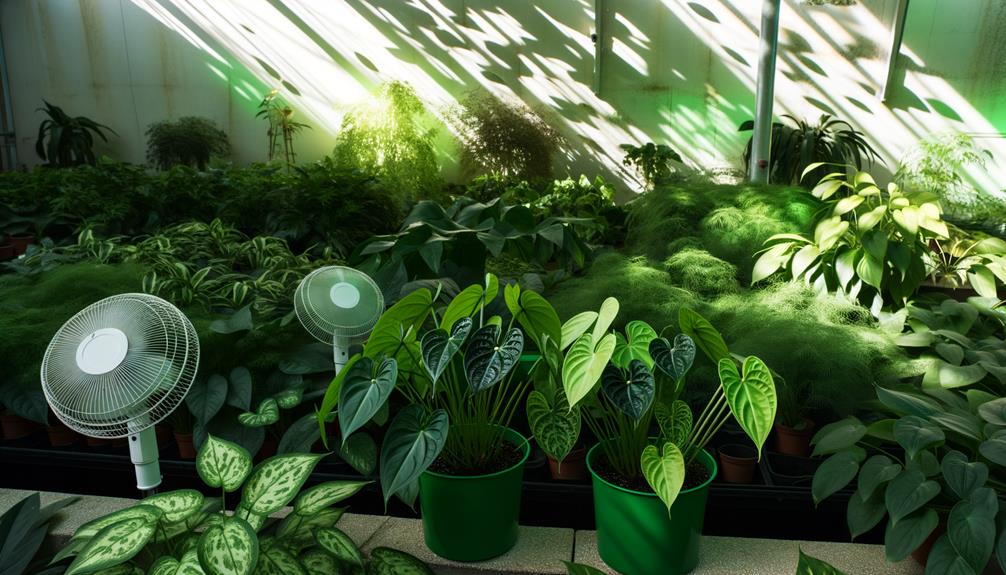
Best air circulation is vital for preventing fungal infections and promoting healthy growth in Anthurium Warocqueanum seedlings.
Effective air movement reduces humidity levels, thereby mitigating the risk of mold and mildew, which are common in stagnant air environments.
Utilizing oscillating fans can improve air distribution, ensuring that moisture does not accumulate on the foliage.
Additionally, positioning the seedlings in a well-ventilated area, ideally with cross-ventilation, helps maintain an ideal microclimate.
Monitoring airflow rates is essential; excessive air movement can desiccate the seedlings, whereas insufficient airflow can lead to pathogen proliferation.
Implementing air circulation systems equipped with humidity and temperature controls can provide a balanced environment conducive to robust growth and disease prevention.
Pest Control
In addition to optimizing air circulation, vigilant pest control measures are essential to safeguarding Anthurium Warocqueanum seedlings against common infestations that can compromise their health and development.
Effective pest management involves regular monitoring and prompt intervention to mitigate potential threats.
Common pests include spider mites, aphids, and mealybugs, each requiring specific control strategies.
- Spider mites: Utilize miticides and increase humidity to deter their proliferation.
- Aphids: Implement insecticidal soap treatments and natural predators such as ladybugs.
- Mealybugs: Apply neem oil or alcohol-soaked cotton swabs directly to infested areas.
Consistent inspection and appropriate treatment protocols are crucial to maintaining the vitality of Anthurium Warocqueanum seedlings, ensuring their robust growth and longevity.
Repotting Guidelines

Repotting Anthurium Warocqueanum seedlings requires careful attention to soil composition, pot size, and timing to guarantee ideal growth.
Selecting a well-draining, aerated substrate is vital, as it prevents root rot and promotes healthy root development.
Additionally, choosing an appropriately sized pot and adhering to a repotting schedule that mirrors the plant’s growth rate are necessary for avoiding root-bound conditions and facilitating ongoing growth.
Choosing Proper Soil
Selecting the right soil for Anthurium warocqueanum seedlings is necessary to ensuring ideal growth and development.
This requires a mix that provides excellent aeration, drainage, and nutrient availability. A well-draining and airy medium helps prevent root rot and promotes healthy root systems.
The following components are recommended for best soil composition:
- Orchid Bark: Enhances aeration and prevents compaction while supporting root growth.
- Perlite: Improves drainage and prevents waterlogging, essential for maintaining ideal moisture levels.
- Coconut Coir: Retains necessary moisture while providing a balanced pH and essential nutrients.
Pot Size Selection
When determining the appropriate pot size for Anthurium warocqueanum seedlings, it is essential to take into account both the current root system’s size and the potential for future growth to ensure plant health and development.
Selecting an undersized pot can restrict root expansion, leading to stunted growth, while an oversized pot may result in poor moisture regulation.
A pot that is 1-2 inches larger in diameter than the root ball is generally recommended. Additionally, the material of the pot should facilitate proper drainage and aeration.
| Seedling Stage | Recommended Pot Size |
|---|---|
| Initial Stage | 3-4 inches |
| Intermediate | 5-6 inches |
| Advanced | 7-8 inches |
Choosing the correct pot size is essential for optimizing growth conditions.
Timing and Frequency
Evaluating the suitable timing and frequency for repotting Anthurium warocqueanum seedlings is crucial for maintaining best root health and promoting strong plant growth.
Seedlings should be repotted when roots outgrow their container, typically every 6 to 12 months. Monitoring root development is essential; overgrown roots indicate the necessity for a larger pot.
Best repotting periods align with active growth phases, commonly in spring or early summer.
Key indicators for repotting include:
- Root-bound condition: Roots circling the pot or emerging from drainage holes.
- Growth stagnation: Slowed or halted foliage development despite excellent care.
- Soil degradation: Compacted or nutrient-depleted substrate necessitating renewal.
These guidelines help Anthurium warocqueanum seedlings thrive by facilitating adequate space and nutrient availability.
Conclusion
To sum up, the cultivation of Anthurium warocqueanum seedlings demands meticulous attention to a symphony of conditions:
- Maintaining an ideal temperature range.
- Ensuring high humidity levels.
- Providing filtered light.
- Utilizing a well-draining soil mix.
- Adhering to a consistent watering schedule.
- Applying balanced fertilization.
- Facilitating adequate air circulation.
- Implementing effective pest control measures.
- Adhering to precise repotting guidelines.
When harmoniously orchestrated, these factors create a thriving environment for the successful growth and development of these delicate seedlings.

